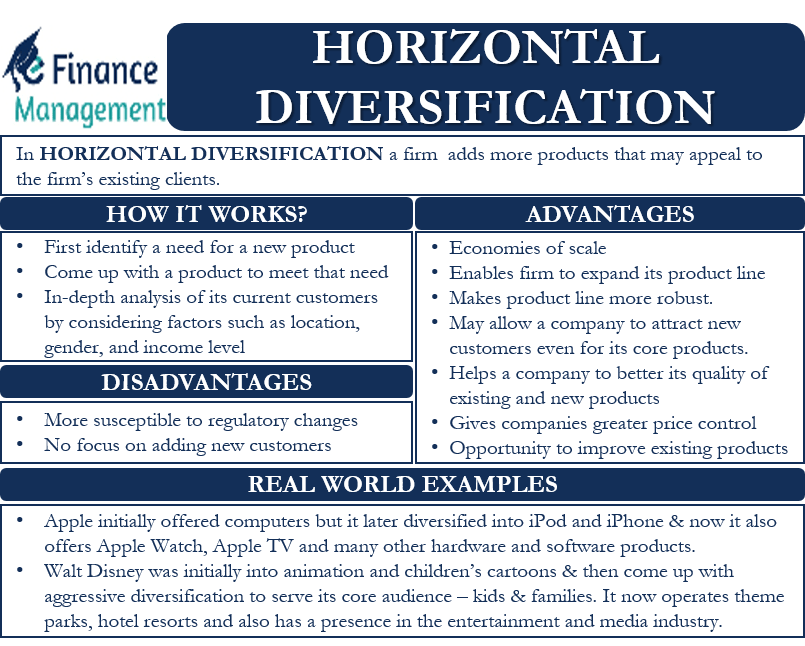Horizontal Diversification is one of the most popular growth strategies. In this, a firm adds more products that may appeal to the firm’s existing clients. The new product (or products) that a company adds is not directly related to its current products. Or, we can say that a company adds new products to its product lines that are not the same as other products in the line. This way, the new products also appeal to the company’s existing customers.
In one way, this diversification strategy is very different from other growth strategies. Most growth strategies focus on adding new customers, but horizontal diversification aims at getting more revenue from the company’s existing customer base.
For example, local retail has a reputation for selling quality jewelry. Using horizontal diversification, the retailer may start selling premium perfumes to magnify the revenues. Another example is when a notebook maker starts to make pencils.
Horizontal Diversification – How it Works?
This diversification strategy works by first identifying a need for a new product and then coming up with a product to meet that need. A company planning such a diversification generally carries an in-depth analysis of its current customers. Also, a company may go for market research by surveying customers on what they want.
This helps determine what other products they may be willing to buy while staying loyal to the current products. Usually, the in-depth analysis considers factors such as location, gender, and income level, to decide on the new products.

Pros and Cons of Horizontal Diversification
Following are the advantages of this type of diversification:
- As the company starts to offer products that complement its existing product line, it may result in economies of scale. Particularly the selling and distribution expenses. And this eventually translates into lower cost reduction.
- It enables the firm to expand its product line. Also, it makes the company’s product line more robust.
- This strategy may allow a company to attract new customers even for its core products. The new product may attract new customers, who may also buy the company’s current product.
- It helps a company to better its quality, both of existing and new products. Since a company analyses its complete existing product line before coming up with a new product, it gives it an opportunity to improve the existing products.
- This type of diversification supports several various optimizations by encouraging a company to come up with products that fit the market.
- It helps in increasing the skill set of the employees as they now are responsible for overseeing two or more products.
- Such a strategy gives companies greater price control.
Following are the drawbacks of this type of diversification:
- A company gets more susceptible to regulatory changes.
- If an existing customer is not satisfied or there is some dispute with the new product, they may also stop buying the core product.
- This diversification strategy does not focus on adding new customers.
Real-World Examples
Below are some of the most popular real-world examples of horizontal diversification:
Apple is a great example of this type of diversification. Initially, the company only offered computers, but it later diversified into iPod and iPhone. Now, the company also offers Apple Watch, Apple TV, and many other hardware and software products.
Walt Disney is also a good example of this diversification. It was initially into animation and children’s cartoons. Since then, it has come up with aggressive diversification to serve its core audience – kids and families. It now operates theme parks and hotel resorts and also has a presence in the entertainment and media industry.
Estée Lauder, which is one of the biggest cosmetics brands in the world, started with just three products: lotions, creams, and cleansing oil. Later the company came up with Aramis men’s fragrance and entered the haircare segment. Also, the company acquired several other cosmetics brands to diversify into related markets.
Pepsi and Coca-Cola also aggressively pursued this diversification strategy. Initially, both the companies were into cold drinks. Later, they diversified into snacks, juices, energy drinks, and mineral water.
Final Words
Horizontal diversification allows businesses to meet more than one need of their customers by offering them a wider range of products. It is the reputation and goodwill of a business that will encourage customers to buy and experiment the new products. And, if the quality and price of the new product (or products) meet the customers’ expectations, then there is a very good chance for the strategy to be successful.
Frequently Asked Questions (FAQs)
In horizontal diversification, a firm adds more products that are not directly related to its current products that may appeal to the firm’s existing clients.
In horizontal diversification, products are diversified by keeping the existing customers in mind. While, in concentric diversification, products are added by considering the existing infrastructure.
Walt Disney was initially into animation and children’s cartoons. And then, it came up with aggressive diversification to serve its core audience – kids and families. It now operates theme parks and hotel resorts and also has a presence in the entertainment and media industry.

